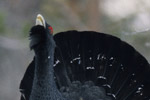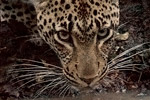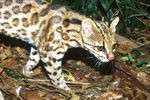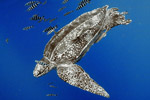
Little dodo baby found: conservationists boosted by discovery that species is breeding. Detail of new painting highlighting the Manumea or little dodo. Painting by: © Michael Rothman 2013.
Almost nothing is known about the little dodo, a large, archaic, pigeon-like bird found only on the islands of Samoa. Worse still, this truly bizarre bird is on the verge of extinction, following the fate of its much more famous relative, the dodo bird. Recently, conservationists estimated that fewer than 200 survived on the island and maybe far fewer; frustratingly, sightings of the bird have been almost non-existent in recent years. But conservation efforts were buoyed this December when researchers stumbled on a juvenile little dodo hanging out in a tree. Not only was this an important sighting of a nearly-extinct species, but even more so it proved the species is still successfully breeding. In other words: there is still time to save the species from extinction so long as conservationists are able to raise the funds needed.
“This is the first time breeding has been recorded in over 10 years,” says biologist Rebecca Stirnemann, who has been working with Samoa’s birds birds since 2010 and is spearheading efforts to learn more about the imperiled species using wildlife drones and the latest in tagging technology.
“Everyone had questioned whether the bird still existed. Now we know it is still alive,” added Moeumu Uili with the Samoan Ministry of Natural Resources and Environment (MNRE). “One of the team, Fialelei, went outside to hang his wet clothes on the line and heard a noise that attracted his attention. He looked up to the tree and saw a bird sitting up high on one of the tree branches. We got our binoculars and camera, and started looking for the hooked bill which is the bird’s distinguishing feature. I started taking as many pictures as I could before the bird flew off. A closer look using binoculars and we knew we had found it, the rare Manumea.”
A bird of many names
The little dodo actually goes by many names. Locally, it’s known as the Manumea and despite its cryptic, almost invisible nature, the species is Samoa’s state bird, even appearing on its currency. Globally, it’s also known as the tooth-billed pigeon and has even been called the “dodlet.” Not to mention, of course, its Latin name: Didunculus strigirostris.
 A juvenile Manumea found in December of last year. Photo by: Moeumu Uili. |
The number of names reveals its distinctiveness: the Manumea is the only surviving member of the genus Didunculus, which in Latin means “little dodo.” A genetics study in 2002, found that the little dodo or Manumea is the most basal member of the dodo’s relatives, both living and extinct.
“[It] is the most ancestral (least derived) member of this group,” Beth Shapiro, the lead author of the study, explains. “It shared a common ancestor with all the other individuals in that group—and was the earliest to diverge from that common ancestor.”
Shapiro speculates that the Manumea could have evolved over 60 million years ago, noting that “pigeons as a whole are a very old group, and the timing of their diversification is not well known.”
The little dodo is characterized by a sharply curved beak with two tooth-like structures on the bottom, a blue head and chest, and dark-red wings. Photos tend to show a crouched, bulky, brooding bird that looks like a cross between a vulture and a dinosaur.
“The Manumea is a big forest pigeon, about the size of a chicken, with an amazingly large bright red beak. That is the first thing you see when you come upon one,” says Stirnemann. “We see them very rarely so it is always very exciting. They can cover large distances quite fast so following them is very difficult. Their speed is surprising since they do not look like they are designed for flight, they have short wings, short tail and a round bulky body. I have now heard them call a few times. The call is a mix of a cow ‘moo’ and a pigeon ‘coo,’ rather endearing.”
Conservation in an information vacuum

Detail of new painting showing off a little dodo in flight. Painting by: © Michael Rothman 2013.
Stirnemann began working with the Ma’oma’o or Mao (Gymnomyza samoensis), a large forest honeyeater in Samoa, but soon got interested in the even more imperiled Manumea (Didunculus strigirostris) as well. However, she quickly found that in order to move forward at all, they were going to have to start from scratch.
“There is so much information which we need to know to save this species. For instance no Manumea nests have ever been recorded in the scientific literature,” Stienemann told mongabay.com. “Therefore we do not know if the nest is on the ground and at risk from pigs or high up in a tree and being predated by introduced black rats. This means we don’t know which invasive pest species is causing the decline of chicks and thus management to protect nests cannot occur.”
 Researchers looking for birds in Samoa. Photo courtesy of Rebecca Stirnemann. |
For the time being, captive breeding is out as well. Stirnemann says researchers aren’t even sure what little dodo chicks eat. They also don’t know how large Manumea territories area.
“At the moment if we see one bird one side of the island and have a second Manumea sighting on the other side of the island, we do not know if they are the same bird traveling a long distance or if it is likely to be two birds, with each bird is only using a small area,” she notes.
In order to begin to piece together the private lives of little dodos, Stirnemann has crafted an ambitious plan: employ small drones and the latest tracking technology to be the first scientists to ever track a Manumea’s day.
“The Samoan forest is beautiful and lush. The plants grow fast and form a dense understory. Walking though this beautiful forest involves quite a lot of chopping and is quite slow,” she explains. “The Manumea on the other hand, flies over the tops of the trees and within a minute is over the gully in front of the people on the ground. Tracking a Manumea is therefore rather difficult. Drones will allow us to also fly over the forest and the gullies, to get close enough to download the GPS information from the Manumea and determine where it has been.”
Stirnemann plans to use new tracking tags developed by Microsoft that can be read by high-flying drones.
“On sensing a weak signal from one postage-stamp-sized tag fixed to an animal, a drone can fly towards the creature on autopilot and retrieve the tag’s data,” she says.
 Photograph of live Manumea in 1901. Photo by: Augustin Kramer. |
The data retrieved from the tiny tags and drones could be key to saving the species from extinction. Once researchers have an idea of the little dodo’s habitat needs, territorial size, and nesting strategies they will be able to begin crafting a real conservation plan. And maybe, just maybe, there is still time for the little dodo to avoid the big dodo’s end.
But they still have to catch a Manumea to tag it.
“Catching Manumea will be tricky since they are so rare,” she says. “However luckily we have recordings of Manumea calls, we will use these calls as a lure to draw them into canopy mist nets. These nets go as high as 26 meters into the canopy. We also now know which trees Manumea are feeding in and when these trees are fruiting so setting up a net near these feeding trees should net us a bird.”
The discovery of the juvenile in December, however, may already present conservationists with a clue about what the little dodo needs and why it’s nearing extinction.
“[The juvenile] was found in the lowland forest,” explains Moeumu Uili. “Little lowland forest remains in Samoa and this discovery suggests it is very important habitat for this species we now must work with the communities to get there support and preserve this special area.”
If scientists can confirm that Manumeas depend on lowland forest, it may spur efforts to save what’s left and perhaps consider plans for reforestation.
The funding gap

Scientists hope these stuffed Manumeas (including juvenile on top) won’t be the only thing left of the species in future decades. Photo by: Michael Rothman.
But it’s not easy to save a species that is almost unheard of outside Samoa, a species that doesn’t exactly follow the usual tropes of beauty, but instead goes its own route, evolutionarily-speaking. Stirnemann says the effort to save the Manumea, and Samoa’s last lowland forests, still requires many champions. She says the project could use help building a local conservation group and increased media coverage. She adds that the team is interested in producing a documentary about their work, but needs a filmmaker.
“We would also love to create a children’s book on the species to build support in Samoa and explain to younger generations the importance of their native environment,” she adds.
 A living adult little dodo or Manumea. Photo by: Ulf Beichle. |
Like all small conservation projects, the efforts to save the little dodo from extinction needs one thing most of all: funding. Last year the conservation work was funded by the Rufford Conservation trust, MBZ conservation grant and Conservation Leadership grant, but Stirnemann says this funding runs out soon. Given this, the conservationists are hoping to begin crowd source funding from the public this year.
“One of the most critical things we need is the funds to hire local staff, a project car and pay for technology needed to track this species needs to be gathered before time runs out,” says Stirnemann.
And, even with the happy discovery of a juvenile little dodo, there is no question that time is running out. The bird’s current trajectory is clear: in the 1980s there were likely 4,000-7,000 Manumeas left, but by the mid-2000s only a few hundred remained. Today, it’s less then 200.
“As with any unique lineage, its extinction would result in the loss of biodiversity,” says geneticist Shapiro. “It is not closely related to any other species, so this would be a huge amount of evolutionary change, gone.”
The little dodo comes to life in art

Micheal Rothman’s Manumeas in Samoa. Painting by: © Michael Rothman 2013.
But as people are hearing about the bird—and its unmistakable nearness to extinction—help has been forthcoming. Last year, U.S. artist Micheal Rothman, got in touch with Stirnemann and offered to give the endangered species its artistic due.
“Upon hearing that no good photos of the Manumea in the wild exist, [Rothman] volunteered to paint a forest scene of the Manumea to show people what could be lost,” she says. “He under took considerable research to make sure the picture was an accurate example of Samoan forest. This involved measuring Manumea skins (from the 1800s right through specimens collected during the Whitney South Sea Expediton of 1923) in the American History Museum of Natural History as well as research into the trees and plants of the Samoan forest.”
 A second photo of the juvenile Manumea in December. Photo by: Moeumu Uili. |
The beautiful painting, which features not one but four Manumeas, finally allows these remarkable birds to take center stage. In Rothman’s heavily-researched work, Manumeas fly and feed with abandon in a pristine Samoan forest.
“His picture will be used to inspire the conservation of this species,” explains Stiremann. “It will also be used to show local people the Manumea so they can help us find new birds.”
But the paintings impact will hopefully go even beyond Samoa, giving the Manumea a larger profile internationally. In fact, the painting will be featured at the New York State Museum’s Focus on Nature XIII Exhibition from April to October.
“My reason for doing the Manumea painting stems from my longstanding interest in conservation biology in general, coupled with my field experiences in Samoa in particular, and my desire to continue to produce artwork with a useful purpose ‘in the world,'” Rothman told mongabay.com. “The extinct dodo of Mauritius has always been a species of wonder for me, and the Manumea, being the dodo’s closest living relative phylogenetically, has a similar attraction. Since the Manumea still exists and by can by definition, be the subject of a coordinated conservation effort, my participation through the creation of related artwork seemed natural to me.”
Without the hard work of conservation champions like Stirnemann, Rothman, Uili, and many others working locally with the bird, the Manumea, tooth-billed pigeon, or little dodo would likely vanish into cold extinction without a whimper. With their dedication, however, it’s possible to imagine that this strange bird can persist long enough to craft a well-informed conservation plan and gather several more champions. In this scenario, the outlook will be sunny for one of the world’s weirdest and rarest animals.

Illustration of the little dodo from the 19th Century likely based on stuffed specimens. By: John Gould.

Black and white illustration of the little dodo or Manumea. By: Gustav Mützel/1882.
Related articles
Extinction warning: racing to save the little dodo from its cousin’s fate

(03/04/2013) Sometime in the late 1600s the world’s last dodo perished on the island of Mauritius. No one knows how it spent its final moments—rather in the grip of some invasive predator or simply fading away from loneliness—but with its passing came an icon of extinction, that final breath passed by the last of its kind. The dodo, a giant flightless pigeon, was a marvel of the animal world: now another island ground pigeon, known as the little dodo, is facing its namesake’s fate. Found only in Samoa, composed of ten islands, the bird has many names: the tooth-billed pigeon, the Manumea (local name), and Didunculus (“little dodo”) strigirostris, which lead one scientist to Christen it the Dodlet. But according to recent surveys without rapid action the Dodlet may soon be as extinct as the dodo.
How hunters have become key to saving Bulgaria’s capercaillie

(02/04/2014) Surprising clatter cuts through the silence in the snowy forest shortly before sunrise. The powerful clicking sounds like a dropping Ping-Pong ball before culminating in a loud pop resembling the opening of a champagne bottle. This sound is heard clearly and far. Propped on a thick pine tree branch, with a peacock-fanned tale, relaxed wings and head pointing skyward, a western capercaillie is singing. The song terminates with a low-frequency sound similar to scraping a fork to the bottom of a frying pan. It’s exactly during those last few moments of singing that something unusual happens: the male bird goes temporarily deaf. Hence the species’ common name in Bulgarian—deaf bird.
Over 75 percent of large predators declining

(01/09/2014) The world’s top carnivores are in big trouble: this is the take-away message from a new review paper published today in Science. Looking at 31 large-bodied carnivore species (i.e those over 15 kilograms or 33 pounds), the researchers found that 77 percent are in decline and more than half have seen their historical ranges decline by over 50 percent. In fact, the major study comes just days after new research found that the genetically-unique West African lion is down to just 250 breeding adults.
Reversing local extinction: scientists bring the northern bald ibis back to Europe after 300 years

(12/02/2013) The northern bald ibis (Geronticus eremita), also called the hermit ibis or waldrapp, is a migratory bird. Once, the bald ibis lived in the Middle East, northern Africa and southern and central Europe, but due to hunting, loss of habitat and pesticide-use, the birds disappeared from most of these areas and is currently considered Critically Endangered. It became extinct in Europe 300 years ago; the bird is almost gone in Syria, with only a single individual recorded at the country’s lone breeding site in 2013; and the only stronghold left is a small population of around 500 birds in Morocco. But now, a team of scientists from Austria is working to reestablish a self-sustaining, migratory population of bald ibis in Europe.
Scientists discover new cat species roaming Brazil

(11/27/2013) As a family, cats are some of the most well-studied animals on Earth, but that doesn’t mean these adept carnivores don’t continue to surprise us. Scientists have announced today the stunning discovery of a new species of cat, long-confused with another. Looking at the molecular data of small cats in Brazil, researchers found that the tigrina—also known as the oncilla in Central America—is actually two separate species. The new species has been dubbed Leopardus guttulus and is found in the Atlantic Forest of southern Brazil, while the other Leopardus tigrinus is found in the cerrado and Caatinga ecosystems in northeastern Brazil.
Leatherback sea turtle no longer Critically Endangered

(11/26/2013) The leatherback sea turtle—the world’s largest turtle and the only member of the genus Dermochelys—received good news today. In an update of the IUCN Red List, the leatherback sea turtle (Dermochelys coriacea) has been moved from Critically Endangered to Vulnerable. However, conservationists warn that the species still remains hugely endangered—and in rapid decline—in many parts of its range.